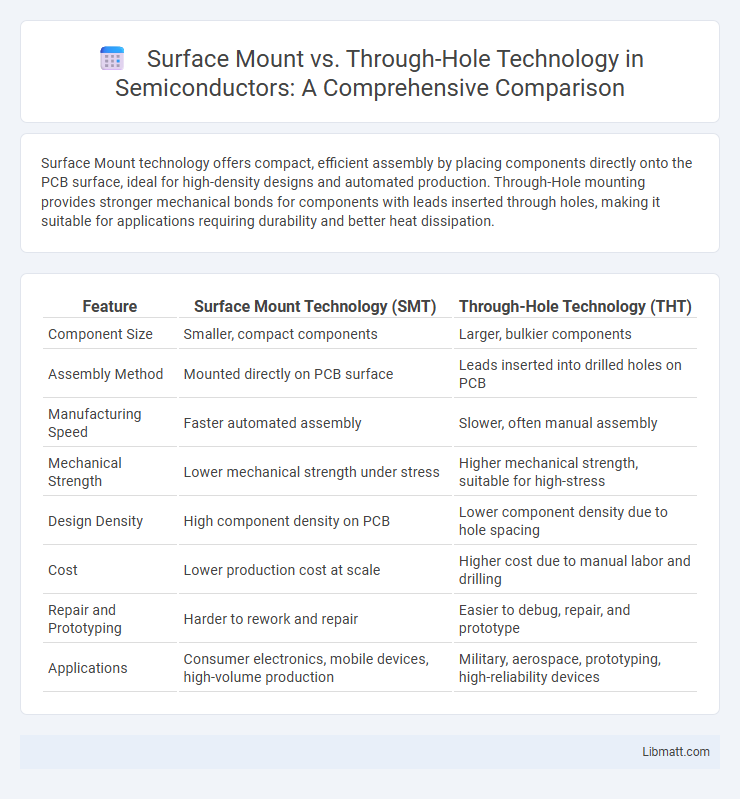Surface Mount technology offers compact, efficient assembly by placing components directly onto the PCB surface, ideal for high-density designs and automated production. Through-Hole mounting provides stronger mechanical bonds for components with leads inserted through holes, making it suitable for applications requiring durability and better heat dissipation.
Table of Comparison
| Feature | Surface Mount Technology (SMT) | Through-Hole Technology (THT) |
|---|---|---|
| Component Size | Smaller, compact components | Larger, bulkier components |
| Assembly Method | Mounted directly on PCB surface | Leads inserted into drilled holes on PCB |
| Manufacturing Speed | Faster automated assembly | Slower, often manual assembly |
| Mechanical Strength | Lower mechanical strength under stress | Higher mechanical strength, suitable for high-stress |
| Design Density | High component density on PCB | Lower component density due to hole spacing |
| Cost | Lower production cost at scale | Higher cost due to manual labor and drilling |
| Repair and Prototyping | Harder to rework and repair | Easier to debug, repair, and prototype |
| Applications | Consumer electronics, mobile devices, high-volume production | Military, aerospace, prototyping, high-reliability devices |
Introduction to Surface Mount and Through-Hole Technologies
Surface Mount Technology (SMT) involves placing electronic components directly onto the surface of printed circuit boards (PCBs), enabling higher component density and automated assembly processes. Through-Hole Technology (THT) requires component leads to be inserted into drilled holes on the PCB and soldered on the opposite side, providing stronger mechanical bonds ideal for heavy or high-stress components. SMT is preferred for compact, high-speed circuits, while THT remains favored in applications demanding durability and manual assembly.
Key Differences Between Surface Mount and Through-Hole
Surface Mount Technology (SMT) involves placing components directly onto the surface of a printed circuit board (PCB), enabling smaller, lighter, and more compact designs compared to Through-Hole Technology (THT), which requires inserting component leads into drilled holes and soldering them on the board's opposite side. SMT components support higher circuit density, faster automated assembly, and improved electrical performance, while THT offers stronger mechanical bonds suited for heavy or high-stress applications. Understanding these key differences helps you choose the appropriate mounting method based on design complexity, durability requirements, and production scale.
Advantages of Surface Mount Technology (SMT)
Surface Mount Technology (SMT) offers significant advantages including higher component density, allowing for smaller and lighter electronic devices. SMT provides improved electrical performance due to shorter lead lengths and reduced parasitic inductance and capacitance. Your manufacturing process benefits from faster assembly times and automation compatibility, resulting in lower production costs and increased reliability.
Benefits of Through-Hole Technology (THT)
Through-Hole Technology (THT) offers enhanced mechanical strength and durability, making it ideal for components subjected to high stress or mechanical wear. The technology provides superior electrical connectivity for large components and high-power applications, ensuring reliable performance in demanding environments. THT's ease of prototyping and repairability facilitates effective testing and maintenance compared to surface mount alternatives.
Applications Best Suited for SMT
Surface Mount Technology (SMT) is best suited for applications requiring high component density, such as smartphones, computers, and wearable devices due to its smaller, lighter components and automated assembly process. SMT excels in mass production environments where speed and cost-efficiency are critical, offering improved performance for high-frequency circuits and complex multilayer boards. Your electronic designs benefit from SMT when miniaturization and reliable signal integrity are top priorities.
Use Cases Where Through-Hole Excels
Through-hole technology excels in applications requiring strong mechanical bonds, such as connectors, switches, and components subject to mechanical stress. It is preferred in prototype development and circuit boards that need frequent manual adjustments or replacements. Aerospace, military, and automotive industries often rely on through-hole mounting for enhanced durability and reliability under extreme conditions.
Manufacturing Processes: SMT vs Through-Hole
Surface Mount Technology (SMT) manufacturing involves placing components directly onto the PCB surface using automated pick-and-place machines, enabling higher component density and faster assembly. Through-Hole technology requires inserting leads into drilled holes followed by soldering, providing stronger mechanical bonds ideal for heavy or high-stress components. Your choice between SMT and Through-Hole impacts production speed, cost, and assembly complexity depending on the application requirements.
Reliability and Performance Comparison
Surface mount technology (SMT) offers superior reliability due to better resistance to vibration and thermal cycling compared to through-hole components, which can suffer from mechanical stress at lead joints. Performance-wise, SMT enables higher circuit densities and faster signal transmission, enhancing overall device efficiency. Your choice between the two impacts product durability and operational speed, with SMT often preferred for modern, high-frequency applications.
Cost Considerations of Surface Mount vs Through-Hole
Surface mount technology (SMT) generally reduces manufacturing costs due to smaller component sizes and automated placement, enabling higher production speeds and lower labor expenses compared to through-hole technology. Through-hole components often incur higher costs from more complex assembly processes and increased material usage, such as larger PCB real estate and manual insertion requirements. Cost efficiency in SMT is further enhanced by improved reliability and reduced need for rework, making it the preferred choice for high-volume, cost-sensitive electronics production.
Choosing the Right Technology for Your Project
Choosing the right technology for your project depends on factors such as component size, assembly volume, and mechanical strength requirements. Surface Mount Technology (SMT) offers higher component density and better performance for compact, high-speed circuits, while Through-Hole Technology provides superior durability and is ideal for prototypes or heavy-duty applications. Understanding these distinctions ensures your design achieves optimal reliability and cost-efficiency.
Surface Mount vs Through-Hole Infographic

 libmatt.com
libmatt.com